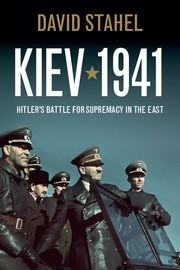Book contents
- Frontmatter
- Contents
- Figures
- Tables
- Maps
- Acknowledgements
- Glossary of terms
- Tables of military ranks and army structures
- Introduction
- 1 The bulldog, the eagle and the bear
- 2 Germany's defeat in the east
- 3 The road to Kiev
- 4 War in the Ukraine
- 5 Ominous horizons
- 6 The battle of Kiev
- 7 Slaughter in the Ukraine
- 8 Visions of victory
- 9 The calm before the storm
- 10 Moscow in the crosshairs
- Conclusion
- Notes
- Bibliography
- Index
6 - The battle of Kiev
Published online by Cambridge University Press: 05 November 2011
- Frontmatter
- Contents
- Figures
- Tables
- Maps
- Acknowledgements
- Glossary of terms
- Tables of military ranks and army structures
- Introduction
- 1 The bulldog, the eagle and the bear
- 2 Germany's defeat in the east
- 3 The road to Kiev
- 4 War in the Ukraine
- 5 Ominous horizons
- 6 The battle of Kiev
- 7 Slaughter in the Ukraine
- 8 Visions of victory
- 9 The calm before the storm
- 10 Moscow in the crosshairs
- Conclusion
- Notes
- Bibliography
- Index
Summary
‘The biggest battle in the history of the world’ (Adolf Hitler)
Even before Hitler's new War Directive 35 was issued, authorizing a renewed offensive from Army Group Centre in the direction of Moscow, Halder was already busily working out the details. In order to concentrate the maximum strength for the coming operation, Halder sought a removal of panzer and infantry divisions from Army Groups North and South in favour of Bock's command. In the north Colonel-General Erich Hoepner's Panzer Group 4 would have first to transfer the 1st Panzer Division as well as the 2nd Motorized Infantry Division, while Leningrad, after much debate within the German high command, was now to become a ‘secondary theatre’. In the south Rundstedt was sent a more complete list of what he would have to relinquish to Bock after the conclusion of the current battle: in total, three infantry divisions from Reichenau's Sixth Army, two panzer divisions (to include the 11th Panzer Division, the other was as yet undecided) and two motorized infantry divisions.
At Army Group Centre Bock was delighted that his ‘old wish’, to attack the main grouping of enemy forces and then to proceed to Moscow, was back on the agenda and this time with Hitler's blessing. Yet upon inspection of the attack plan Bock had considerable reservations. In essence he was concerned that the opening encirclement was too tight and needed to be screened to the east by a secondary force pushing much deeper into Russian territory. ‘I asked [Lieutenant-Colonel Helmuth von] Grolman [of the Operations Department at the OKH] to make it clear from the start that the planned tight turn by both of the attack's offensive wings does not correspond to my view in this case…this has to be screened to the east.’ Yet Bock's criticism touched on a major of point contention from July. At that time Hitler had expressed serious misgivings about the practice of large encirclements that, in his opinion, did not allow for decisive results. Not only did Bock have reservations about the strategic approach to the offensive, but he also wanted more forces to carry it out. In the north he requested ‘the strongest possible forces’ from Colonel-General Ernst Busch's Sixteenth Army, operating as part of Leeb's Army Group North. Bock claimed that, without such support, the attack by Strauss's Ninth Army would be too weak and that ‘outflanking the enemy will be out of the question’. He approached Brauchitsch about this, but in the aftermath of the recent strategic crisis the Commander-in-Chief of the Army proved ‘evasive’ and was unwilling to make any promises that did not already have the approval of Hitler or the OKW. At the same time Bock complained that Army Group South was ‘causing difficulties’ because Reichenau's Sixth Army had built bridges that could not support tanks and consequently the transfer of the 11th Panzer Division could not take place. As Bock concluded in frustration, ‘I’m not getting much help in putting the new operation together and yet everything depends on it!’
- Type
- Chapter
- Information
- Kiev 1941Hitler's Battle for Supremacy in the East, pp. 206 - 237Publisher: Cambridge University PressPrint publication year: 2011



